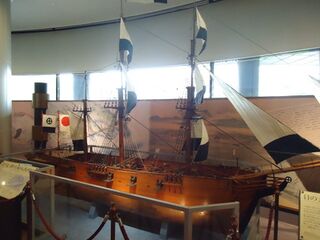Difference between revisions of "Shoheimaru"
(Created page with "*''Built: 1853-1854'' *''Japanese'': 昇平丸 ''(Shouhei maru)'' The ''Shôheimaru'' was a Western-style tall-masted sailing ship, constructed at the orders of [[Shi...") |
|||
| (4 intermediate revisions by the same user not shown) | |||
| Line 1: | Line 1: | ||
| − | *''Built: [[1853]]-[[1854]]'' | + | [[File:Shoheimaru.JPG|right|thumb|320px|A model of the ''Shôheimaru'', on display at the Museum of the Meiji Restoration in Kagoshima]] |
| + | *''Built: [[1853]]/5-[[1854]]/12'' | ||
| + | *''Other Names'': 琉球大砲船 ''(Ryuukyuu taihou sen)'', 昌平丸 ''(Shouheimaru)'' | ||
*''Japanese'': 昇平丸 ''(Shouhei maru)'' | *''Japanese'': 昇平丸 ''(Shouhei maru)'' | ||
| − | The ''Shôheimaru'' was a Western-style tall-masted sailing ship, constructed at the orders of [[Shimazu Nariakira]], lord of [[Satsuma han]], in [[1853]]-[[1854]]. It was 31 meters long, with three masts, ten cannon, two mortars, four turret guns, and a displacement of 370 tons, and was given as a gift to the [[Tokugawa shogunate]]. | + | The ''Shôheimaru'' was a Western-style tall-masted sailing ship, constructed at the orders of [[Shimazu Nariakira]], lord of [[Satsuma han]], in [[1853]]-[[1854]]. It was 15 ''ken'' (approx. 27-31 meters) long, four ''ken'' one ''shaku'' (7.5 m) wide, and three ''ken'' (5.5 m) deep, with three masts, ten cannon, two mortars, four turret guns, and a displacement of 370 tons, and bore a crew of forty. |
| + | |||
| + | The project got its start when Shimazu Nariakira, in response to pressures from Western powers, ordered his retainer Tahara Naosuke to research Dutch shipbuilding texts. Construction began in 1853/5 at Setomura on [[Sakurajima]], one month before [[Commodore Perry]] arrived at [[Uraga]] Bay. The ship was initially called ''Ryûkyû taihôsen'' ([[Ryukyu Kingdom|Ryûkyû]] cannon ship), but by the time it was completed in 1854/12, after 19 months of trial and error, it was renamed ''Shôheimaru'' (昇平丸). | ||
| + | |||
| + | The ''Shôheimaru'' sailed to [[Edo]] in [[1855]] without incident, in only 26 days, against the wind, and as the first ship flying the ''[[Japanese flag|Hinomaru]]'' flag Nariakira devised (which would later become the national flag). Later that year, in the 8th month, the ship was renamed again, from 昇平丸 to 昌平丸 (both pronounced ''Shôheimaru''), and it was given as a gift from Nariakira to the [[Tokugawa shogunate]]. [[Katsu Kaishu|Katsu Kaishû]] sailed the ''Shôheimaru'' back to [[Nagasaki]] the following month, where it was to be used by the shogunate's naval training academy. | ||
| + | |||
| + | In [[1869]], following the fall of the shogunate, the ''Shôheimaru'', along with the ''[[Kanrin Maru]]'', among other ships, were used to ship settlers and development materials to & from [[Hokkaido]]. The ship ran aground at Esashi, Hokkaido, in [[1870]], marking the end of its career. | ||
{{stub}} | {{stub}} | ||
| Line 8: | Line 16: | ||
==References== | ==References== | ||
*Gallery labels, permanent exhibits gallery, [[Shokoshuseikan|Shôkoshûseikan]], Kagoshima, Sept 2014. | *Gallery labels, permanent exhibits gallery, [[Shokoshuseikan|Shôkoshûseikan]], Kagoshima, Sept 2014. | ||
| + | *Gallery labels, Museum of the Meiji Restoration, Kagoshima, Sept 2014.[https://www.flickr.com/photos/toranosuke/21372010265/sizes/k/][https://www.flickr.com/photos/toranosuke/21519324366/sizes/h/] | ||
[[Category:Ships]] | [[Category:Ships]] | ||
[[Category:Bakumatsu]] | [[Category:Bakumatsu]] | ||
Latest revision as of 11:48, 19 August 2016
- Built: 1853/5-1854/12
- Other Names: 琉球大砲船 (Ryuukyuu taihou sen), 昌平丸 (Shouheimaru)
- Japanese: 昇平丸 (Shouhei maru)
The Shôheimaru was a Western-style tall-masted sailing ship, constructed at the orders of Shimazu Nariakira, lord of Satsuma han, in 1853-1854. It was 15 ken (approx. 27-31 meters) long, four ken one shaku (7.5 m) wide, and three ken (5.5 m) deep, with three masts, ten cannon, two mortars, four turret guns, and a displacement of 370 tons, and bore a crew of forty.
The project got its start when Shimazu Nariakira, in response to pressures from Western powers, ordered his retainer Tahara Naosuke to research Dutch shipbuilding texts. Construction began in 1853/5 at Setomura on Sakurajima, one month before Commodore Perry arrived at Uraga Bay. The ship was initially called Ryûkyû taihôsen (Ryûkyû cannon ship), but by the time it was completed in 1854/12, after 19 months of trial and error, it was renamed Shôheimaru (昇平丸).
The Shôheimaru sailed to Edo in 1855 without incident, in only 26 days, against the wind, and as the first ship flying the Hinomaru flag Nariakira devised (which would later become the national flag). Later that year, in the 8th month, the ship was renamed again, from 昇平丸 to 昌平丸 (both pronounced Shôheimaru), and it was given as a gift from Nariakira to the Tokugawa shogunate. Katsu Kaishû sailed the Shôheimaru back to Nagasaki the following month, where it was to be used by the shogunate's naval training academy.
In 1869, following the fall of the shogunate, the Shôheimaru, along with the Kanrin Maru, among other ships, were used to ship settlers and development materials to & from Hokkaido. The ship ran aground at Esashi, Hokkaido, in 1870, marking the end of its career.
References
- Gallery labels, permanent exhibits gallery, Shôkoshûseikan, Kagoshima, Sept 2014.
- Gallery labels, Museum of the Meiji Restoration, Kagoshima, Sept 2014.[1][2]
